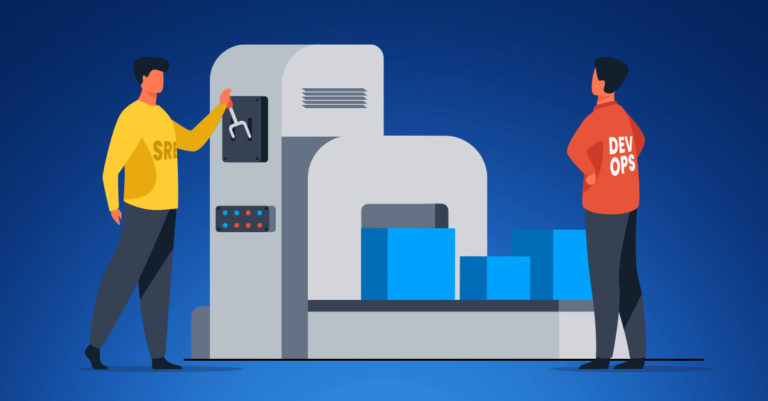
DevOps vs. SREs: Are They Two Peas in a Pod?

Senior Content Manager
So you’re a DevOps engineer…or are you an SRE (aka, Site Reliability Engineer)?
These roles are often blurred together and can mean different things depending on your organization.
Google famously wrote an entire book outlining the role, philosophy, and approach of SREs–defining it simply as “what happens when you ask a software engineer to design an operations team”.
Meanwhile, famous works such as The Phoenix Project by Gene Kim, Kevin Behr, and George Spafford as well as The DevOps Handbook by Gene Kim, Jez Humble, Patrick Debois, and John Willis established DevOps as a new framework for streamlining development and operations in order to improve workflow and product quality. They define DevOps as “architectural practices, technical practices, and cultural norms that allow us to increase our ability to deliver applications and services quickly and safely.”
Both these philosophies involve breaking down silos between various roles within IT. Both of them rely heavily on automation to free engineers from mundane tasks. They both invest in tooling to improve workflows. And finally, both are obsessed with measuring results and improving their processes.
So what’s the difference?
According to Google’s Seth Vargo and Honeycomb.io’s Liz Fong-Jones, SREs “embody the philosophies of DevOps with a greater focus on measuring and achieving reliability through engineering and operations work.”
Simple right?
If you’re still scratching your head trying to understand the difference between these two approaches, you’re in the right place. We’ll take a deep dive into the similarities and differences between SREs and DevOps below.
What is DevOps?
DevOps is an engineering philosophy that combines development and operations to ensure full-cycle ownership, improve code and product quality, remove silos between developers and operations, and create fast/efficient release cycles. Unlike SREs, DevOps is not necessarily a role, but rather, a set of cultural objectives.
A main feature of this approach involves CI/CD processes (Continuous Integration and Continuous Delivery) which entails the perpetual automation and monitoring throughout the app development lifecycle; integration, testing, delivery, and deployment.
Using code repositories such as GitHub or GitLab is another defining characteristic of DevOps. Once code is tested for bugs, it is uploaded to a code repository in order to improve visibility, and streamline the deployment process. From there, it is automatically pushed into production.
DevOps Engineers are focused on both speed and quality. And they do this through continuous improvement – meaning they’re constantly iterating and making incremental improvements to their software as part of their workflow. As a result, code is pushed faster and with far fewer bugs.
Tooling is also critical when it comes to DevOps. Some of the most critical and commonly used tools include Git, Kubernetes, Docker, Terraform, Ansible, Jenkins, Datadog, Splunk, Chef, Puppet, and others.
What is an SRE?
A site reliability engineer typically comes from an operations background and uses their skill set for scaling, managing, and operating systems and infrastructure.
Their core functionality is to ensure reliability, sustainability, and scalability of the underlying systems so that the products and services released by their organization are both resilient and highly functional for users. SREs have clearly defined roles and objectives, and typically split their time between developing new products, services, and operations.
Automation is of key importance to SREs because it enables them to streamline operational tasks at a faster rate without risk of human error, so they don’t spend too much of their precious time maintaining systems and infrastructure.
They use SLAs (service level agreements), SLIs (service level indicators), and SLOs (service level objectives) to determine and measure the reliability of their system and evaluate whether or not they can release a new product or feature. An SLA is a commitment the organization makes to their users regarding reliability, security, and support. SLOs are the objectives the organization must meet to ensure they are in compliance with the SLA. And the SLIs are the metrics they use to measure the process.
Another aspect of the SRE philosophy is the assumption that systems will inevitably fail. As part of their SLO, the SRE department determines the amount of downtime and number of acceptable errors they’re allowed to have within an entire product line.
Key Differences Between DevOps and SREs
While both DevOps and SREs seek to eliminate the silos between development and operations, they do so in a different way. The DevOps approach is through implementing specific cultural changes that emphasize agility and full-cycle ownership, while SREs are meant to serve as the intermediary between developers and operations as they have expertise in both areas.
While DevOps is mainly a set of cultural practices which focus on agility, speed, efficiency, and quality, SREs emphasize reliability, stability, standardization, and performance. They are less about culture and more about putting together protocols that ensure the overarching stability of their systems.
In essence, DevOps is a culture without clearly defined roles and responsibilities, whereas an SRE is a type of engineer with established goals, objectives, and responsibilities.
Their approach to failure is also different. SREs accept failure as inevitable and try to reduce its impact on the end-user. In contrast, DevOps have testing and continuous improvement as a core part of their processes to try and ensure quality is always upheld.
While stability and reliability are important for DevOps, for SREs this is their bread and butter. Likewise, while speed might be a factor for SREs, for DevOps, it is critical.
For this reason, tooling is especially important for DevOps as it enables them to push code to production faster, while continuously eliminating bugs or errors.
What do both DevOps and SREs agree upon? As we said above, they both believe in removing silos between devs and ops. Another commonality between the two is automation. They both use this technology as an essential part of their workflow–DevOps to push code into production faster, and SREs to streamline operations and ensure the overall health of their systems.
Final Thoughts
So while very similar, DevOps and SREs are not exactly the same. In some organizations, such as Google, having a more defined role is ideal, making SREs the preferred model, while in other organizations, DevOps is a more popular approach. Believe it or not some organizations even employ both!
It’s also worthwhile to mention that other big tech companies have an entirely different outlook. For example, Meta created the role of Production Engineer, which combines software and systems engineering to “champion the Reliability, Scalability, Performance, and Security posture of production services”.
Despite all of these nuances, DevOps tends to have a bit more of a following with a huge variety of books, sites, podcasts, events, and newsletters dedicated to helping DevOps engineers solve some of their most pressing challenges. However, SREs have no shortage of interesting content to help them maximize their potential as well.
So whether you’re a DevOps Engineer or an SRE, or even a Production Engineer– your work of building the next generation of technology is incredibly important. While you may approach your tasks differently from one another, both philosophies can coexist to take our technology to the next level and create happy, loyal users for years to come.
Love to hear about the latest in automation? Check out Zesty’s cloud automation technology! Find out how Zesty can help you improve cloud efficiency and maximize savings with zero effort. Talk to one of our cloud experts to learn more.
Related Articles
-
 Why it’s time to get off the manual Kubernetes optimization treadmill
Why it’s time to get off the manual Kubernetes optimization treadmill
August 14, 2025 -
 The endless cycle of manual K8s cost optimization is costing you
The endless cycle of manual K8s cost optimization is costing you
July 2, 2025 -
 This is the #1 cloud budget killer (and it’s easier to fix than you think)
This is the #1 cloud budget killer (and it’s easier to fix than you think)
June 16, 2025 -
 K8s users were waiting years for this, and v1.33 just made it real
K8s users were waiting years for this, and v1.33 just made it real
June 12, 2025 -
 Why Most K8s Optimization Strategies Fail (And How to Fix Yours)
Why Most K8s Optimization Strategies Fail (And How to Fix Yours)
May 20, 2025


